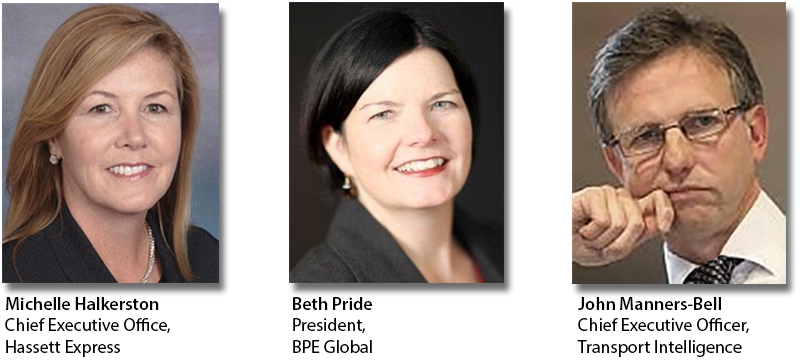Shipper Strategies and the Freight Forwarder Maze

Global logistics managers have always been under pressure to find the right balance of specialized intermediaries matched with the markets they want to serve, and that challenge is becoming increasingly complex as mega-brokerage enterprises capture more share.
While new overseas opportunities may be tempting some shippers to expand their reach, industry analysts contend that most are still being cautious.
The prospect of finally having the Trans-Pacific Partnership (TPP) implemented has many forwarders excited, and, on paper, the opening of markets in Cuba and Iran also looks promising.
However, the cold hard facts at the moment point to a continuing decline in U.S. exports.
“The trade sector will continue to hold back growth for the next two years since the dollar continues to strengthen, and since the effects of a strong dollar take several quarters to filter through into prices and quantities,” says Patrick Newport, U.S. economist for IHS Global Insight.
Year-to-date, exports dropped by $3.7 billion and were weak across the board. Exports of industrial supplies and materials, which are sensitive to commodity prices, fell by $2.2 billion.
“The most recent numbers suggest that trade will be a drag on third quarter growth, but the bite will likely be a reduction in real GDP growth of about 0.5 to 1.0 percentage points, depending on November trade figures.”
Impact of Trade Agreements
Just when it appeared that agreement among participants comprising the TPP would not be reached this year, the Office of the United States Trade Representative announced that recent discussion rounds in Atlanta produced consensus.
Shippers and forwarders have been championing this deal even as it appeared “dead in the water” this past summer.
The National Association of Manufacturers (NAM), for instance, was especially bullish on this proposition. “The TPP negotiations have long presented a lot of hope for manufacturers in the U.S. and the millions of jobs they affect,” says Linda Dempsey, NAM’s vice president of international economic affairs.
“If done right, this TPP agreement has the potential to boost U.S. manufacturing growth and global competitiveness”
The Airforwarders Association (AfA), representing 360 companies and more than 300,000 employees who move air cargo through the supply chain, also hailed the agreement. “The record on trade agreements is clear,” says AfA’s executive director Brandon Fried.
“They allow American businesses to sell products and services to the 95 percent of consumers who live outside the U.S.”
The TPP agreement includes a series of member agreements to lower tariffs, modernize customs border clearance, and ensure a level playing field for competition.
“Lowering tariffs and streamlining Customs border clearance operations are music to our ears, as this will spur increased trade both to and from the U.S.,” says Michelle Halkerston, CEO of Hassett Express and board president of the Airforwarders Association.
“As freight forwarders, we recognize that liberalized trade agreements are critical to business both large and small that seek to expand their markets”
That does not mean that caution is being thrown to the wind, however. Indeed, freight forwarders are carefully watching the Asia Pacific region for signs that a slowdown in China’s economic growth will have an impact on its neighbors. This threat would be exacerbated if the country experiences a “hard landing” in which GDP growth sinks below 5 percent for at least one year.
Risk in Burgeoning Markets
When it comes to doing business in Cuba and Iran, however, shippers may want to stay with the bigger, globally connected freight forwarding intermediaries - if they care to get into these markets at all.
Beth Pride, president of BPE Global, a consultancy specializing in import/export operations and the development of global supply chain security programs, advises extreme caution when it comes to trade and regulatory compliance in these burgeoning trade regions.
“With Cuba’s designation as a State Sponsor of Terrorism rescinded, the Anti-Terrorism (AT) license requirements from Cuba were removed and references to Cuba as a ‘bad actor’ were eliminated,” Pride says.
“But that doesn’t mean shippers can relax. The country is still subject to a comprehensive embargo, and the list of license exceptions allowed for Cuba is shorter than the list of license exceptions we’re used to”
Trade with Iran is equally problematic, says Pride, and shippers who have tried to penetrate the Russia and Ukraine market may not be interested at all.
“Our government seems a bit out of touch regarding the realities of running a successful and profitable business - while also being compliant - in these complex times,” says Pride.
“We love the concept of Export Control Reform, but it seems as soon as things start to head in a more efficient direction something happens to complicate the ability to comply and keep U.S. businesses competitive at the same time”
Yield Dilution
However, globalization is no longer “the only macro-trend in town,” says John Manners-Bell CEO of Transport Intelligence (Ti), a London-based consultancy.
“Although it’s still a work in progress and should not be dismissed, there are a number of other trends helping shape the market for shippers and their forwarders as well as the strategies they have to adopt in order to survive.”
One of the longest-term trends in the freight forwarding industry has been dilution of yields, meaning that forwarders have to work harder to maintain their revenues. A new report from Ti suggests that there are a number of reasons for this, including a shift in modes from air to sea.
“Global manufacturers have found ways in which to flex their supply chains to utilize lower cost sea freight rather than more expensive air cargo,” says Manners-Bell. A key driver behind this trend was the economic downturn, which prompted shippers to look at ways to “de-cost” their supply chains while still maintaining their efficiency.
Restructuring production schedules has also been part of this trend, as well as encouraging consumers to pre-order, removing much of the risk of holding too much inventory.
“Even higher-value producers, such as consumer electronics companies, have adopted sea freight strategies, although air cargo uplift is often employed to meet the global demands of new product releases, and after an initial surge, the ongoing demand is often met by shipments moved by sea, computer peripherals, such as screens, that were often moved by air are now far more likely to be shipped by container”
Researchers say that this may seem “counter-intuitive,” as sea freight transit times are increasing as shipping lines introduce slow steaming in order to reduce fuel costs.
This shift has been most pronounced on the Asia-to-Europe and Asia-to-US trade lanes, the two most important, indicating how vital this has been in reducing lucrative, high-value volumes to the detriment of the freight forwarding sector.
“For a number of years, we have also been witnessing the waning importance of intercontinental trade volumes to the sector,” says Manners-Bell. “We asked respondents to our survey which lanes they thought had witnessed the highest growth, and intra-Asia came up as the fastest growing for yet another year.”
Manners-Bell says this has a profound effect on freight forwarders. “Not only are intra- Asian movements much cheaper than those to either Europe or North America, but also the global forwarders have far less strength in this segment than they do in Asia-Europe or Asia-U.S. trades. This is especially the case in China-Japan trade,” he adds.
Global Shift
The global logistics industry is already seeing a major change to the relationship that drove its development for the last three decades and before, contend analysts.
On average, between 1990 and 2008, real GDP grew at 3.2 percent a year, while world trade grew at twice this rate. This relationship was considered to be “hard-wired” - that is, until the financial crisis of 2009. The 2:1 ratio has since been replaced with more like a 1:1 correlation, meaning that most trade forecasts were first affected by the downturn and then affected by a structural change in market growth.
Ti researchers say that there are several reasons for this. The first is that developed countries - including the Eurozone - have yet to fully recover, and therefore there’s less demand for imports of consumer goods. Second, developing countries have been forced to focus their investment on domestic infrastructure to maintain economic growth. China is the best example of this.
Third, the global economic downturn has created more protectionist policies, which have acted as a drag on international trade. Furthermore, governments around the world have actively suppressed short-term consumer demand in their own economies.
And finally, the outsourcing trend to the Far East in 1980s, 1990s, and 2000s was a “one-off gain” for international trade. Since then, the increase in volumes has been incremental, as most production processes that could be unbundled and outsourced to remote manufacturing locations in Asia already have been.
Technology is the Great Equalizer
According to Ken Lyon, managing director of the London-based consultancy Virtual Partners, the majority of smaller forwarders are using technology to manage their businesses. “However, this usually has happened as a result of necessity rather than as part of a strategic decision process,” he says.
Lyon, a 30-year industry veteran and Ti advisor, notes that as technology has advanced, costs have come down and capability has increased.
“The general availability of solutions running in the cloud and available on a monthly subscription basis has been a game changer,” he says.
“Much of the functionality now available ‘on demand’ is a match for the existing solutions developed internally (at great cost) by the large integrated carriers and multi-national logistics companies.”
Lyon and other analysts contend that operating costs of cloud solutions are very low and their ability to scale - also on demand - provides tremendous flexibility.
Meanwhile, the larger forwarders have developed solutions over many years to support the business requirement of predictable, rigid operating practices capable of handling huge volumes of orders and shipments.
These platforms are usually a mix of tightly integrated applications that are expensive to maintain and difficult to change.
“Technology will be the deciding factor in the success of freight forwarders all over the world,” observes Michael White, international marketing manager at UPS.
“Those who choose to invest and embrace will thrive and those who do not will lack the capacity to provide customers with the visibility and reliability they need.”
Both Lyon and White agree that a layer of risk is also introduced with the advent of more sophisticated tools - especially mobile devices.
“The users in large companies expect that they will be able to use these tools in concert with their corporate systems,” says Lyon. “This raises issues of security, interoperability, and data ownership.”
Lyon adds that the information services functions in both the shipper and forwarders sectors face a daunting prospect of supporting the needs of the business while dealing with a tsunami of different demands for access to more data, increased functionality and managing the retirement of legacy systems and implementing new ones.
“The smaller forwarder, using solutions in the cloud, may not yet have access to technology that is as tailored and feature-rich as a dedicated in-house solution,” concludes Lyon.
“At the same time, the little guy can get a very large percentage of that at much lower cost and available within days - and at last he’ll be able to compete and prevail.”
Related Article: What Does the Future Hold for Freight Forwarders?

Top Freight Forwarder White Papers
A Freight Forwarder’s Guide to Achieving Competitive Advantage
Freight forwarding is a complex business. Managing multiple customers and multimodal transport carriers, customs challenges, fluctuating demand and currencies all add up to a big challenge that stands between you and competitive advantage.
The Future of Logistics – What Does the Future Hold for Freight Forwarders?
Kewill worked with Transport Intelligence to examine the state of the global freight forwarding industry, and produced a report that provides an in-depth look at the issues confronting forwarders across the globe – and offers helpful suggestions on what they need to do to remain competitive.
Article Topics
BluJay Solutions News & Resources
5 Signs You May Need a More Modern Supply Chain Solution How Supply Chains are Becoming Resilient Amid Disruptions Supply Chain 2020 Innovation Update BluJay research focuses on the need to build resilient supply chains 5 Signs It’s Time to Modernize Your Supply Chain Technology Supply Chains of the Future Boost the Power of Your Trading-Partner Network More BluJay SolutionsLatest in Transportation
Baltimore Bridge Collapse: Impact on Freight Navigating Amazon Logistics’ Growth Shakes Up Shipping Industry in 2023 Nissan Channels Tesla With Its Latest Manufacturing Process Why are Diesel Prices Climbing Back Over $4 a Gallon? Luxury Car Brands in Limbo After Chinese Company Violates Labor Laws The Three Biggest Challenges Facing Shippers and Carriers in 2024 Supply Chain Stability Index: “Tremendous Improvement” in 2023 More TransportationAbout the Author




















